|
|
|
|
|
| |
Quality general dental care with an emphasis on natural esthetics, form and function. Experience with complex restorative, prosthetic and implant treatment.
----------------------------------------------------------------------------------------
PORCELAIN VENEERS:
Dental veneers are custom-designed laboratory fabricated shells of ceramic material that are shaded to look like tooth enamel. When applied over the surface of a tooth, they can cover worn tooth enamel, correct uneven tooth alignment or spacing, fix chips or cracks and change the color of the teeth to a lighter shade.
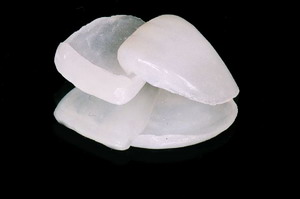
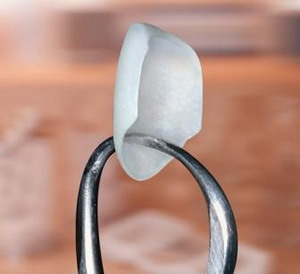
Indications
Veneers may be used to restore a single tooth that may have been fractured or discolored, or multiple teeth to create a "Movie-star" type smile makeover. Some people have small teeth resulting in spaces (diastemas) between the teeth that may not be easily corrected by orthodontics. Other people may have worn the edges of their teeth resulting in a prematurely aged appearance, while others may have malpositioned teeth that appear crooked. Multiple veneers can be used to close these spaces, lengthen teeth that have been shortened by wear, provide a uniform color, shape, and symmetry, and make the teeth appear straight. Dark shaded and stained teeth can be masked giving you the smile you have always wanted.
Dental veneers fall into the category of cosmetic dentistry because they create a brighter, whiter smile with beautifully aligned, shaped teeth. The translucent quality of today's ceramic veneers provides a more natural look than what's been available in the past. The nuances in shade and highlights seen in beautiful natural teeth can be mimicked in the ceramic providing truly natural looking teeth and a beautiful smile.

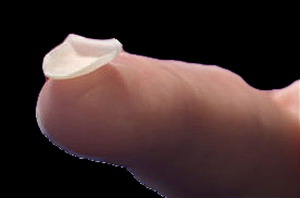
Regardless of what causes unattractive teeth, dental veneers may solve most or even all of your cosmetic dental issues, including:
Worn enamel: Over time, the thin, hard substance covering your teeth (enamel) may become worn, dulled, and discolored. Such wear and discoloration may be natural or the result of habits such as consuming soft drinks, tea, or coffee, or smoking, medication use when younger (tetracycline which may cause purple tint to the tooth or in extreme cases a banded appearance) or tooth grinding.
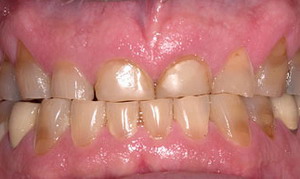
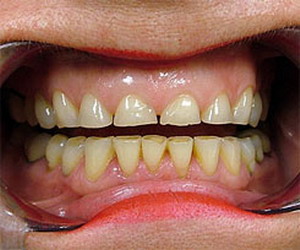
Chips and cracks: Over time as the enamel on the edge of the tooth wears this may lead to chipping of the enamel or cracks may develop in the tooth’s surface which may pickup stain and become more obvious. This uneven appearance gives the teeth an aged appearance.
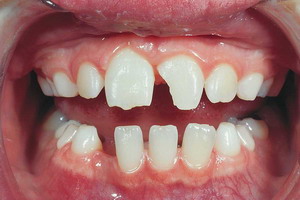
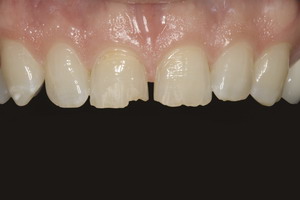
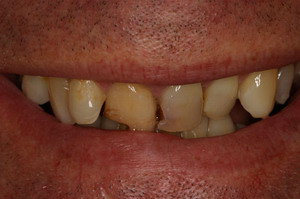
Spacing: Some people may be born with abnormal spacing between the teeth that grows wider as they age. This sometimes is a result of teeth that are out of proportion to the size of the jaws they are in.

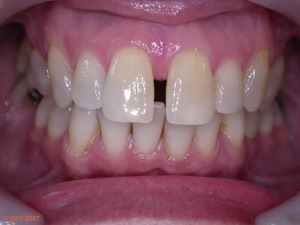
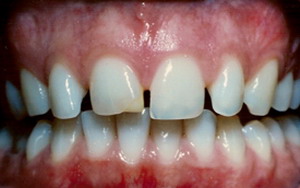
Crooked teeth:Teeth that are crooked can be corrected orthodontically (braces) but the patient may chose to have those treated with veneers which will allow correction of the shade and complete treatment is a short period of time (several weeks).
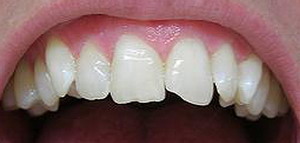
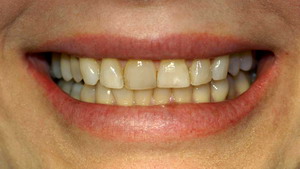
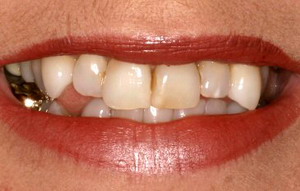
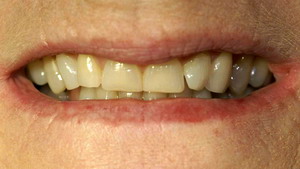
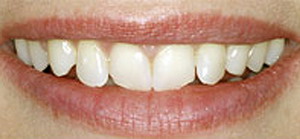
Discolored teeth: Teeth may become discolored for a variety of reasons which may include; prior trauma to the teeth, medications when a child, smoking and drinking beverages that with staining potential (ie. Coffee, tea, caramel colored sodas, cherry flavored drinks).
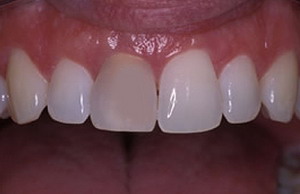
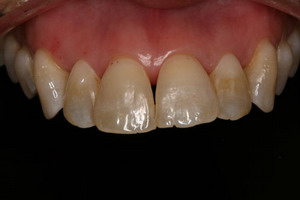
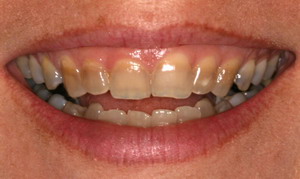
Porcelain Veneers and Composite Resin Veneers
The two most common materials used in the manufacture of dental veneers are composite resin and porcelain veneers. Both porcelain veneers and composite veneers can be fabricated by a dental technician in a dental laboratory; composite veneers can also be directly fabricated inside your mouth at the dental office.
Dental veneers that are indirectly fabricated – fabricated in a dental laboratory – are bonded to the teeth with various types of resin cement. Of the two options, porcelain veneers are longer lasting and more expensive
Veneers or Whitening:
Tooth whitening (bleaching) may provide a whiter smile for mildly discolored teeth and may be the choice for patients who are happy with the shape of their teeth and only wish to brighten them. Those teeth that have fillings on the visible surface will not readily whiten with bleaching as restorative materials are not affected shade wise by the materials used to bleach teeth. Some people whose front teeth do not have fillings in them but are misaligned may benefit from whitening in combination with some simple orthodontic alignment. The placement of dental veneers requires the “shaping” or “prepping” of the teeth being fitted with the custom-designed shells. If you have a severe case of dull or discolored teeth or the teeth have significant old fillings present, you may benefit from veneers. Veneers do have the added benefit of longevity and a proven ability to enhance the appearance of the mouth, smile, and possibly other areas of an aged face that would be better supported by properly shaped teeth. Although veneers require a much larger commitment than teeth whitening, the results are typically well worth it.
Veneers Consultation and Treatment Planning
How do I know if I am a candidate for veneer treatment? To determine if veneers are right for you, your dentist will schedule a preliminary consultation during which available treatment options will be discussed. Veneer treatment is irreversible, so it is important that your dentist discuss any alternatives that provide the same results, but with minimal, to no removal of tooth structure. If you and your dentist decide that veneers are the best option, the next step would involve a thorough review of the details, including preparing your teeth for your specific veneer treatment and what will be necessary for them to look and fit correctly.
During your veneers consultation, you will actively participate in the "smile design process." By sharing your desires for your smile about the shape, length, width and color of the veneers and the effect you want them to have on changing the appearance of your smile. This will help ensure that your veneer treatment will meet your expectations. It is important that your dentist understands your objectives when undergoing a veneer procedure.
The Dental Veneer Procedure
The dental veneer procedure begins with impressions for study models. After mounting the models the teeth on the models are waxed to the ideal shape. This allows the dentist to determine what parts of the teeth will need to be reduced and will permit a matrix that will serve as a guide to fabricate temporary veneers that will be placed at the preparation appointment.
At the preparation appointment a stent will be used to determine where the teeth need to be reduced to allow preservation of tooth structure. An impression is taken of the prepared teeth and temporary veneers replicating what the final veneers will look like are placed. An impression is taken of these in the mouth to act as a blue print to the laboratory to guide them in fabrication of the permanent veneers. Some patients require anesthetic for this visit while other patients are comfortable without any injections of local anesthetic for the preparations as the teeth are not prepared very deeply. A shade is selected for the final veneers and the patient is dismissed.
If there are esthetic concerns it may be decided to have the patient wear the temporary veneers for 2-3 weeks before submitting the impressions to the laboratory. This will allow modifications of the temporary veneers to shorten, lengthen or reshape the temporaries.
Upon receipt of the veneers from the laboratory the patient returns to the office and the temporary veneers are removed. The veneers are tried in and the patient’s is allowed to see their new smile. Upon approval of the shade and shape of the veneers, the teeth are treated to allow bonding of the veneers to the underlying tooth structure.
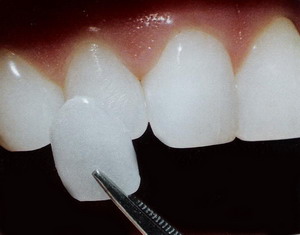
Maintenance of your veneers
Although the veneers are strong, it is generally recommended that care should be taken and some things avoided with the veneers. These include;
- Avoiding opening things with your teeth
- When eating hard fruits like apples and pears, it is recommended to cut them in slices verses biting into the whole fruit
- Avoid abrasive toothpastes that are sold for smokers, have baking soda or for whitening as these may dull the finish of the veneers.
- Avoid chewing ice
- Brushing and flossing will keep the gum tissue around the veneers healthy and decrease the possibility of decay on these teeth.
Case: Very dark tetracycline staining with banding.
Maxillary teeth corrected with feldspathic porcelain veneers to mask stain and brighten the smile
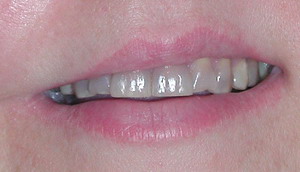
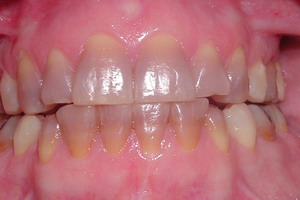
Before
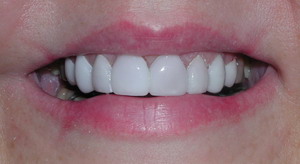
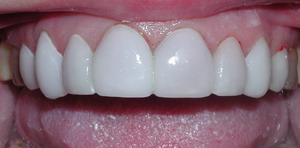
After
Implant Cosmetic Dental Center™
----------------------------------------------------------------------------------------
Dr. Gregori M. Kurtzman is an international lecturer, selected as one of the top 100 dental speakers since 2006 by Dentistry Today, author of over 200 professional articles, a consultant to multiple dental manufacturers for product evaluation, development and research, he provides general dental care in suburban Maryland since 1986.
|
|
|
|
|
|
|
|
|